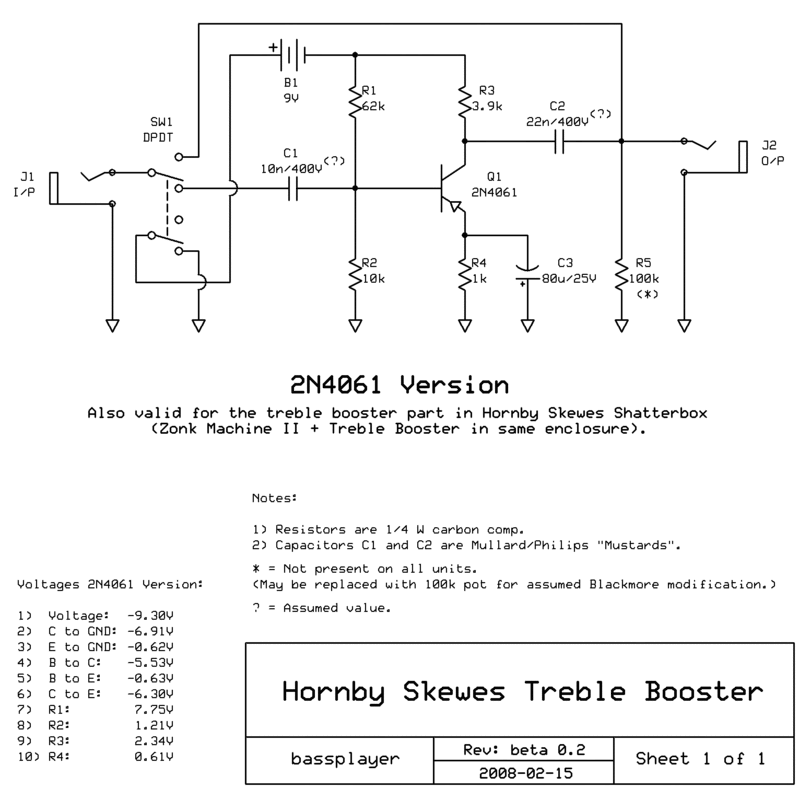*This page also has a schematic for the Fred Briggs Rangemaster*
So, we all know there are many vintage treble/bass booster designs out there that were developed in the 1960s which were designed to give your tube amp the extra kick it needed to get some lovely tube saturation. Even with the huge number of modern stompboxes that promise to give you the ultimate booster people still love the old designs and cherish the tones they provide. But here's the problem; the increasing rarity of the key germanium transistors which are required to give them their original vintage vibe. Anyone who has built a germanium based pedal recently can testify that finding germanium transistors with the correct gain and leakage characteristics can be a frustrating (and expensive!) experience.
So, what to do? Easy, come up with a new design that still gives all those vintage tones but uses easy to source parts. However, before we start lets have a look at some of the more popular vintage boosters that are out there. Firstly the legendary Dallas Rangemaster:
And the Apollo Treble/Bass booster:
The Hornby Skewes Selectatone Treble/Bass Booster:
The Hornby Skewes Treble Booster:
 |
| This unit also built with an OC44 Ge Transistor |
And the Orange / Vox / Apollo Treble/Bass Booster:
Ok, so what am I suggesting we do? Find some germanium, that's what we need to do - easily obtainable germanium. Impossible? No. The Russians were using germanium for a long time after the West stopped and their production methods produced transistors that were a lot more consistent than our attempts.
For example I have a pack of 50 MP14b transistors I bought on a whim from ebay for about £10. I tested them all and 95% of them came back good with gains from 25-40hfe and leakages of less than 200mA (most were less than 100mA!). Very nice, but the gains are a little low. Luckily there is a little trick in transistor land called the "darlington configuration": http://en.wikipedia.org/wiki/Darlington_transistor
Configuring transistors like in essence creates a single transistor which has a gain equal to the product of the gain's of the two individual transistors. Ok, so if I have two transistors each with a gain of only 25hfe I end up with one transistor with a gain of 625... Hmmm, far too much, but there is a way to force the circuit to think the gain is lower. Pete Moore of Diystompboxes.org did this:
Using a low gain (~50hfe) OC44 and a medium gain silicon transistor) he created a hybrid Rangemaster he called the "Rangepig". It sounds great and using the 100k trim pot you can blend in the amount of germanium "dirt" you want while still gaining the bite and gain characteristics of the silicon transistor. Does it sound like an original Rangemaster? Well, no, not completely but it does sound pretty damn good and it really adds an extra dimension to the age old design.
MartyMart makes this comment on the circuit:
"Pete posted this up a week or so ago and it's a wonderful circuit. Built with an OC44 and a 2N3906, I used 47n in/out caps, so it's a bit more of a full range pig! Great "twist" on a rangemaster, which has a gorgeous clear sparkle to it, like a nice "sheen" to chords/picking. The 100k trimmer lets you dial in some Ge "grit" or you can leave it very smooth. A great "boosting" tool for sure.
10/10, thanks Pete for a simple/great sounding gift!"
Another option is to not use germanium at all and go for easy to obtain silicon transistors. Here's a circuit presented by Will Firstbrook (strangely enough also called the Rangepig!):
This circuit uses piggybacked (where have we seen those before?!) silicon transistors to emulate the lower gain of germanium devices. Another advantage of this circuit is that is NPN negative ground so can be used with a standard power supply without causing problems when you connect other pedals. You could of course build Pete Moore's Rangepig as NPN but germanium npn transistors are hard to find...
I've tried both of these circuits and played around with them both a bit too on a breadboard. So, which do I prefer? I prefer Pete Moore's Rangepig. I think it allows you to still get the classic germanium tone while also allowing you to dial in some more gain if you like. Using cheap but consistent Russian germanium transistors let you get the same result everytime without having to spend mega bucks on sourcing some ultra rare decent OC44s. Don't get me wrong though, Will's Rangepig still sounds damn good, it just doesn't have quite the same tweak-ability that I enjoy so much about Pete's design.
*UPDATE* Here's a schematic for my version of the Rangemaster, incorporating Pete's darlington transistors and a few circuit mods that are about for the Rangemaster:









The treble parade would have been the most perfect moment of my footballing life, but for the two people standing behind me, clearly already plotting their next move. See the link below for more info.
ReplyDelete#treble
www.ufgop.org
Confused a little here - with Will's Range Pig, the collector of Q1 goes...where? Just to C7? Means no collector supply, surely not right? Should it not go to the collector of Q2 as well?
ReplyDeleteHmmm
What an excellent post guy . I appreciated it . Keep up it sharing . Image Retouching | Image Masking Service | Image Cropping
ReplyDeleteAnd what about the Burns Treble Boost, ca. 1965 - does anyone know where to find the schematic? It used an NKT213 red spot germanium transistor and would make a nice little project...
ReplyDeletePlease post any help, thanks.
McThing